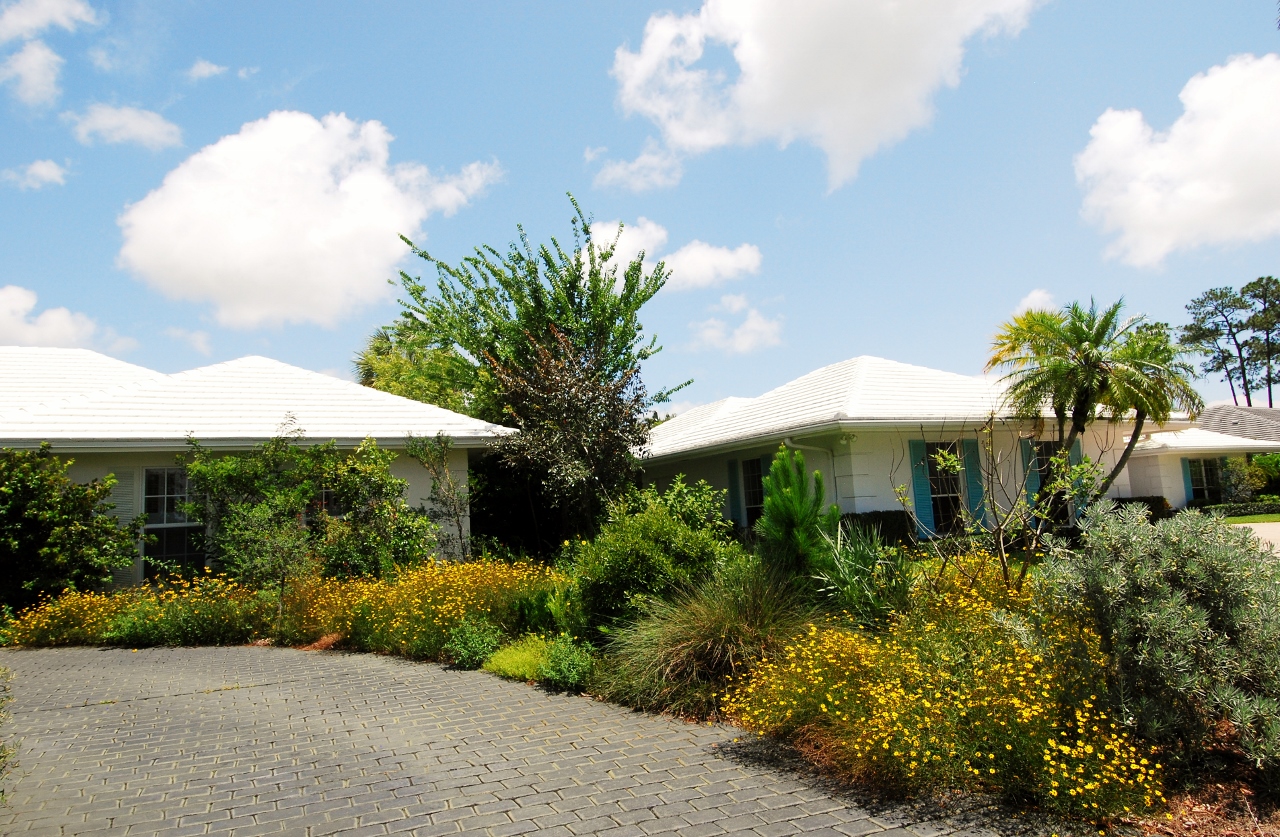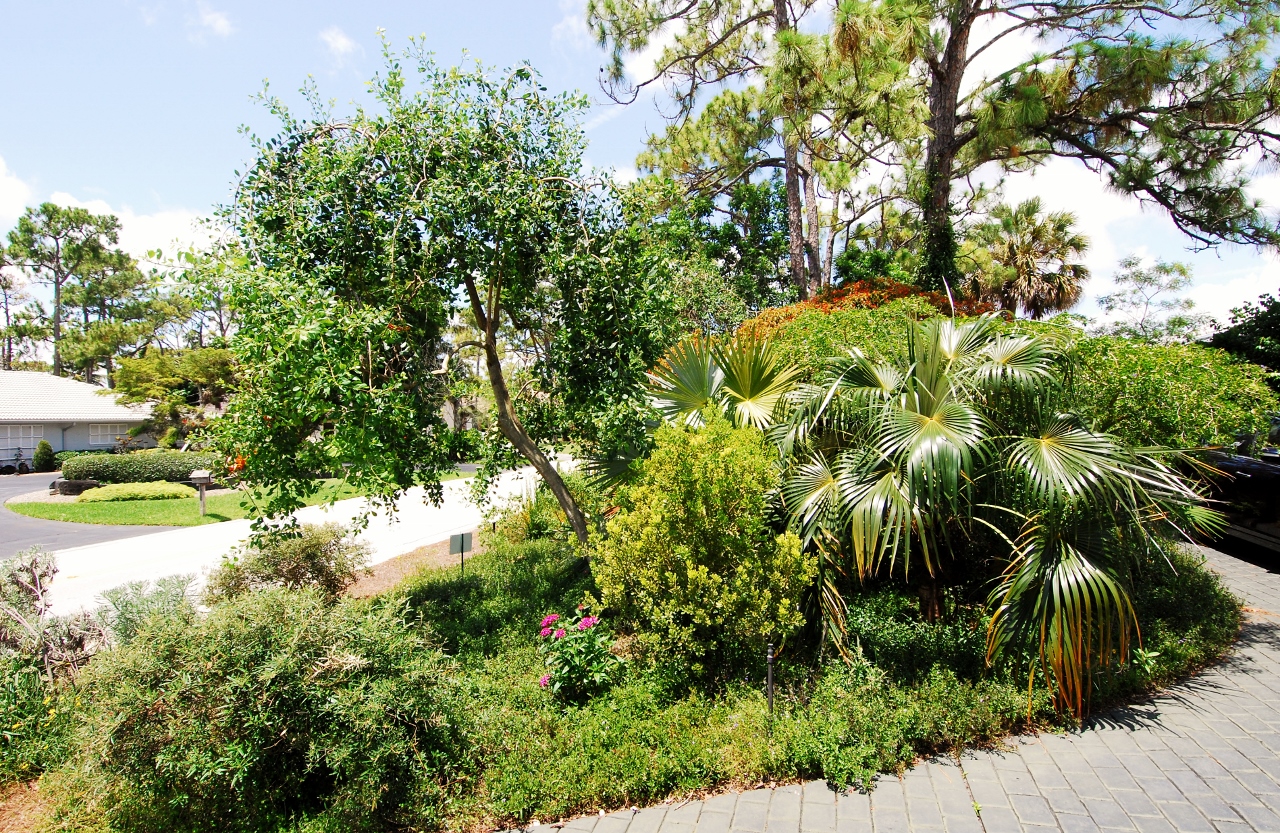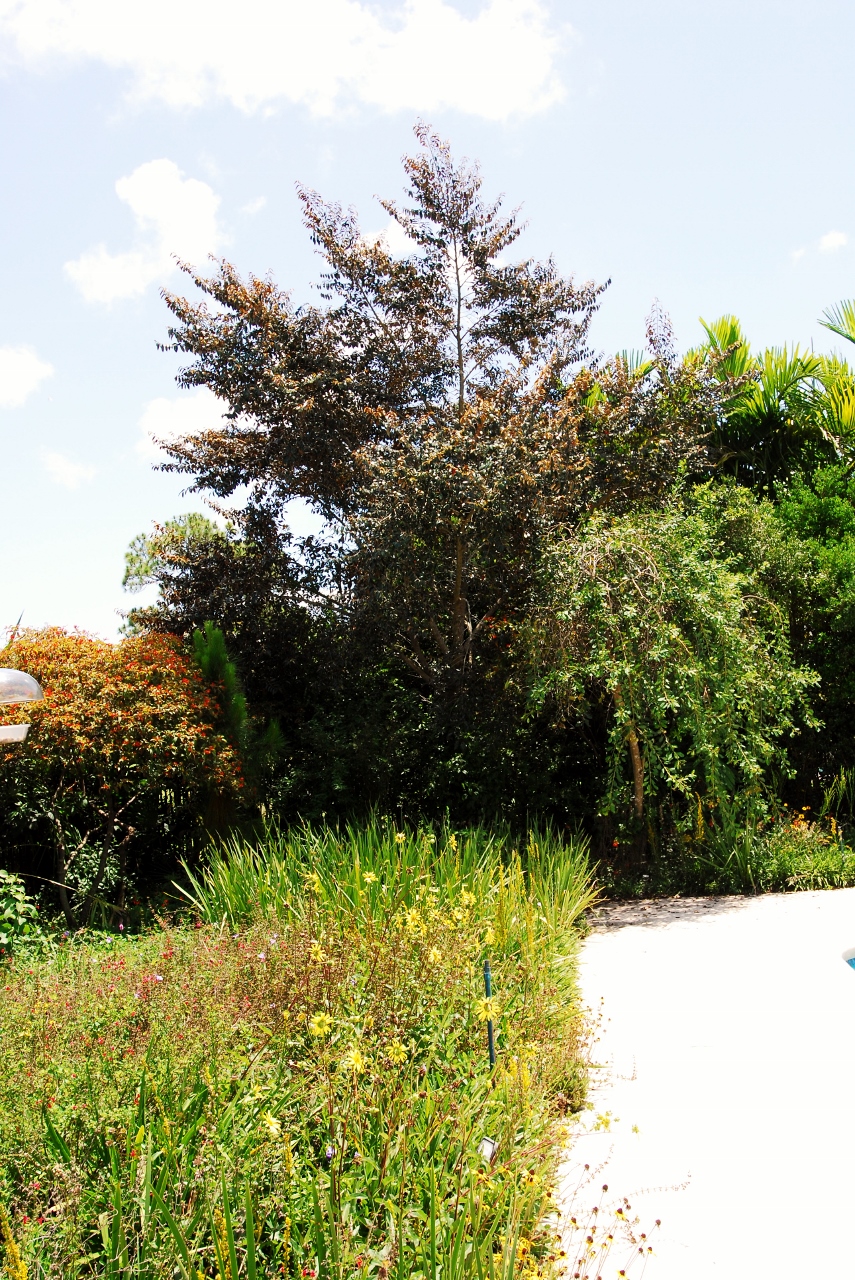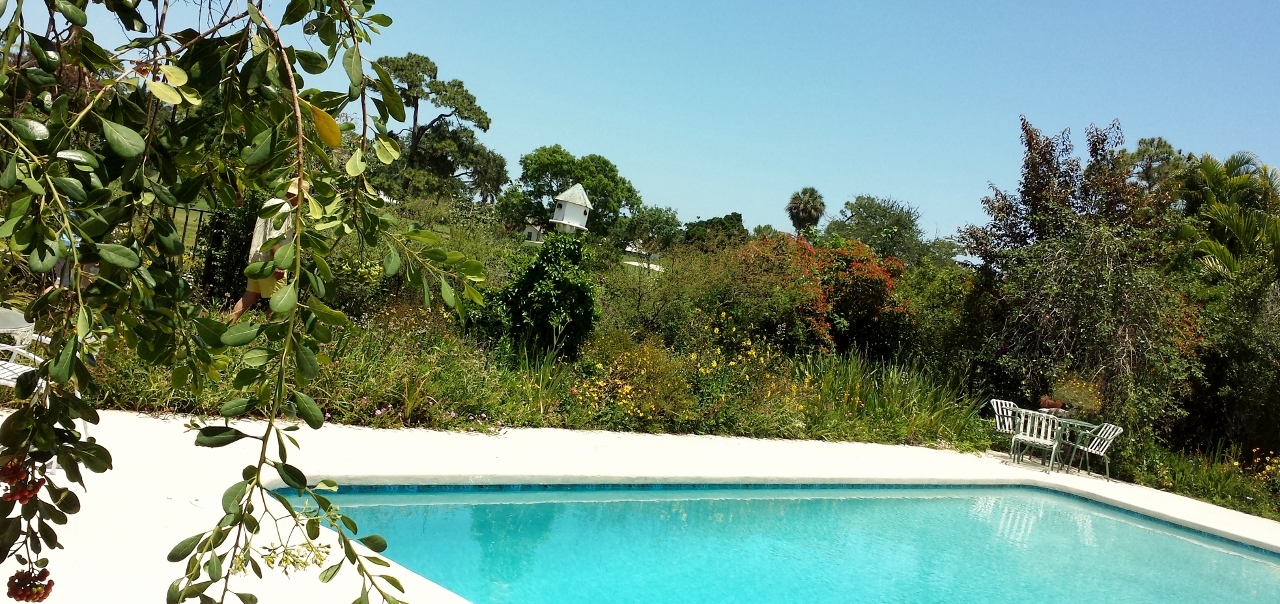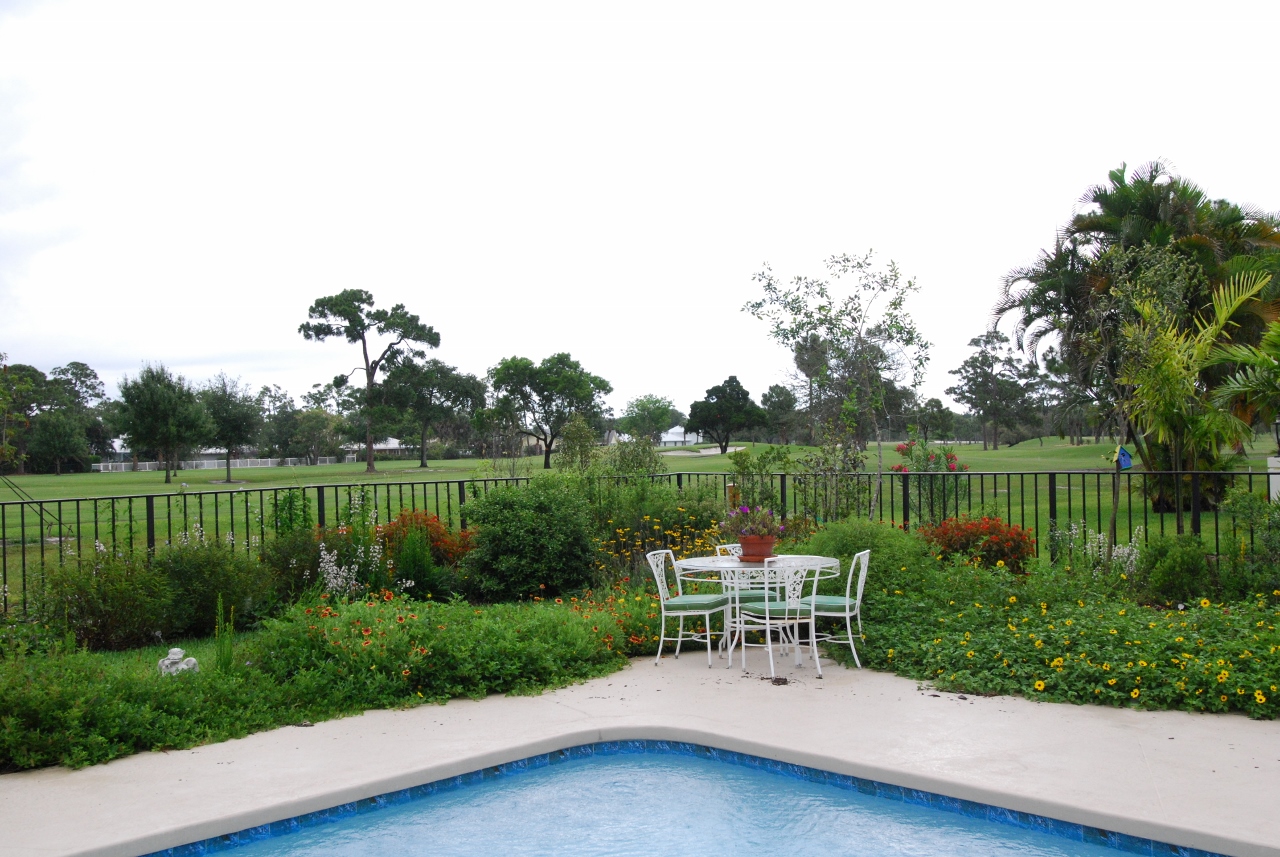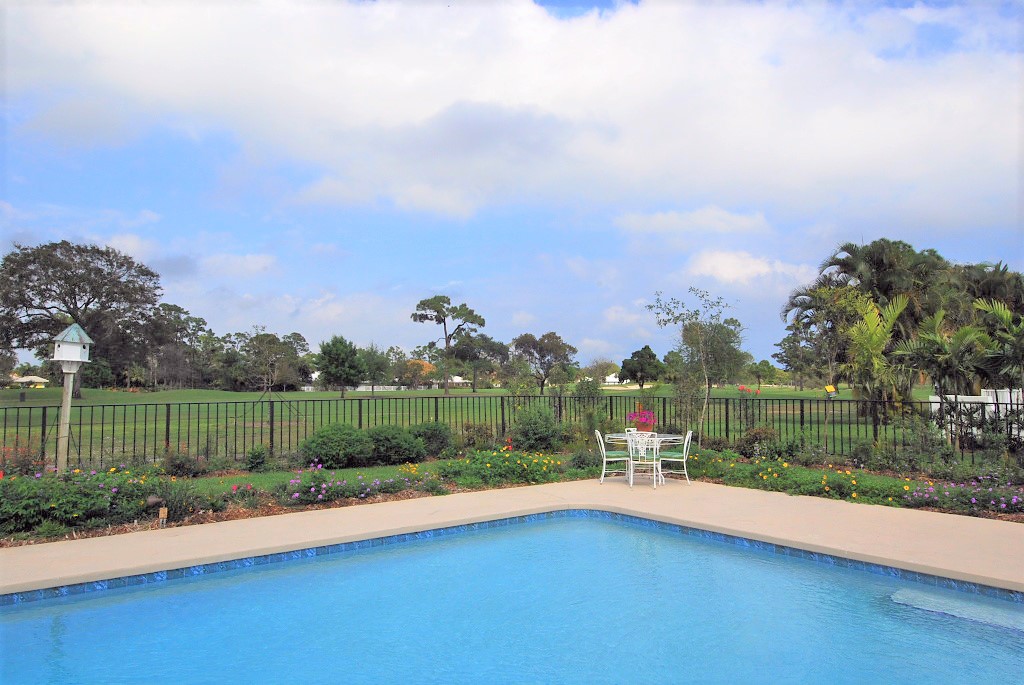Buffie’s Front Yard after Seven Years
You can see a pineland theme on the right with a small Slash Pine, Coreopsis, Muhly Grass, Saw Palmetto, Gopher Apple and overlapping Sea Lavender from the coastal front theme. As you go to the right of the house behind the Satinleaf there is a wetland theme.
This contains Florida Elm, Dahoon Holly, Swamp Dogwood, Myrsine, Water Hickory, Swamp Redbay, Coastal Foxtail and others. The native ferns covering the ground give this section a very woodsy feel similar to what you would experience in the Orlando area.
The Lignum Vitae, in the center between the palms, grew from four feet to this size in just three years. With watering twice a week and fertilization, this plant has grown into a specimen worth over two thousand dollars. Not bad for a two hundred dollar investment.
Buffie’s Front Yard at Seven Years
The Silver Palm, Joewood, Lignum vitae, Bahama Strongbark, Pineland Croton and Sea Lavender have grown in beautifully. The ground covers include Twinflower, Havana Scullcap, Quailberry, Coreopsis and a lone Penta, which is not native.
To the right and rear is a thick privacy screen of Firebush, Hercules Club, Black Bead and other shrubs. The whole area is alive with butterflies and birds all year long.
Buffie at Seven Years
Every year or two you will need to cut back and shape some of your plants. This is a more wild look which attracts butterflies and local and migratory birds including hummingbirds. There are bursts of color throughout the year as different plants flower and fruit. Although you can trim these plants the way exotics are shaped…why?
Buffie’s Yard at Three Years
Here you can see that the Satinleaf on the right is quite large. The wildflowers have grown in and some have been replaced. Patches of Prairie Iris cover the ground with blue green spears and will be full of three inch blue flowers from March to May.
It is time to cut back the Firebush and other shrubs and limb up the trees. Notice that their privacy from golfers and neighbors is complete.
Buffie’s yard at six months
The Dune Sunflower, Gaillardia, Black Eyed Susan, Beard Tongue and Firebush are now blooming heavily and the shrubs and trees are taking off. This is April when a lot of growth starts. Little growth of trees and shrubs occurs between January and April.
The first month after planting Buffie’s yard
This is the first month after planting and already the Dune Sunflower and Beach Verbena are blooming yellow and purple. The shrubs are still small, but watch them grow over the years.
The golf course takes away their privacy and will be completely screened out in just two years. There are Saw Palmetto, Locust Berry, Jamaica Caper and other shrubs planted on the other side of the fence. They took about four years to really take off and are now full sized.
Care of Your Plants
Wildflowers: Require a week of daily watering and some slow release fertilizer to become established. They may need watering two to three times a week until the end of the month if showing signs of stress.
Water wildflowers once a week, if needed, during long dry periods after the initial establishment period.
Shrubs and Trees: Require two weeks of daily watering and every three days for an additional month. There is a period from March to July that may be especially dry; this ends with the summer rains.
During this time your plants may require watering every two to three days depending on the moisture holding capacity of the soil.
Within three to six months, most trees and shrubs should be on their own unless there is no rain for more than two weeks.
Always keep an eye on your plants and water them if necessary as it may take one full year before some trees and shrubs are fully established and can make it through our long dry spells.
When planting, pull apart the roots from opposite or three sides of the root ball to break up any roots that have completely circled the inside of the pot.
These will otherwise continue to get thicker in diameter until they strangle the trunk years later.
To do this run your thumb from top to bottom and about two inches into the ball or cut with a shovel. Make sure you don’t cut the root where it begins at the trunk.
The plant should be installed so that the top of the root ball is level with the ground and the soil is firm beneath the root ball. Never put organic matter below the root ball as it will oxidize causing the plant to sink.
If the soil is too loose beneath the plant, it may settle and you will find the root ball several inches below the surface in a few months. Replant if this happens.
Build a ring of soil around the outside of the root ball with the extra soil to hold the water in place when you water.
Use a forceful stream from the hose to soak the soil; a sprinkle will do little to wet the ground. Make sure you water a few inches outside the ring to encourage the roots to move out.
Florida has a variety of soils to deal with. Coastal and scrub soils, which are just west of and east of I95 to the ocean, are very dry. Plants in these soils require more weeks of watering as well as frequency.
Traveling west of this zone the soil becomes moister, yet may have pockets of scrub, until wetlands are encountered near the turnpike and beyond. If your soil is always moist, your plants will only need the first week of watering and as needed thereafter.
Use a slow release fertilizer to help your plants send down their roots. The three to 12 month fertilizers work well. Flowers will need one treatment and trees and shrubs may need three.
Keep weedeaters away from your plants, they will girdle the lower trunk and kill the plant. Stake the tree loosely, if at all, so that it can move and strengthen.
Cut your shrubs back several inches to a foot or two by hand only if needed. Don’t sheer them or the growth will be on the outer tips and none in the center.
In fact, cut the shrub to the ground to rejuvenate. Not all plants can take this but firebush, beauty berry, wild coffee, locust berry, necklace pod and a few others will come back fine. Try this on one plant first.
If you notice insects causing a lot of damage, especially newly introduced ones, try the organic oils or other sprays to control them. Since these introduced insects have no enemies, they can multiply unchecked and kill your plants.
When I plant for you I often need to cut some or your plant’s roots to fit them around a pipe or tree root. This results in wilting and the need for you to water these plants more frequently and longer. The wilting may last a month, so please be patient.
Call me if you have any further questions
Carl Terwilliger
561-601-9673
